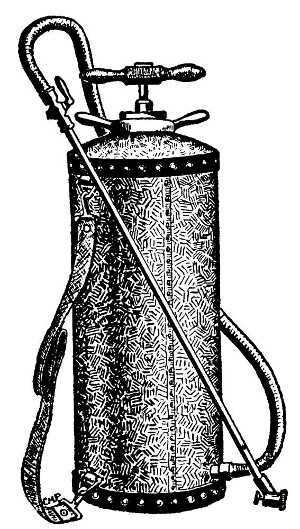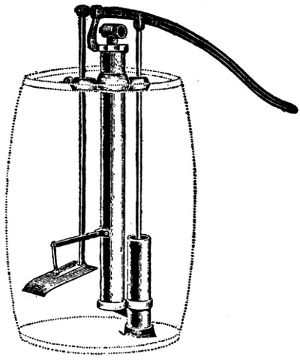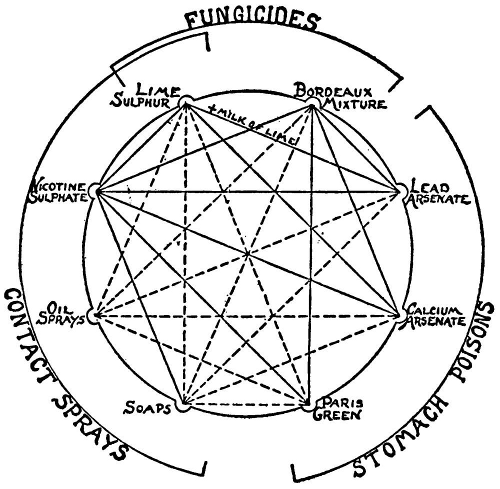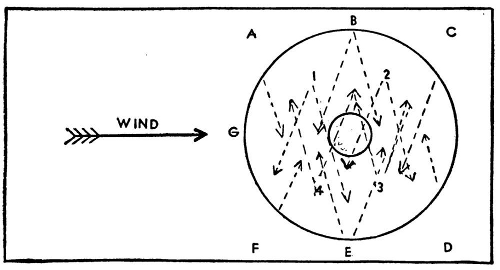The following information on spraying and dusting comes from Five Acres and Independence by M. G. Kains. Five Acres and Independence is also available to purchase in print.
Hundreds, if not thousands, of amateur gardeners and even many professionals are annually disappointed because their spraying or dusting produces either no noticeable results or perhaps does actual damage to their plants. Despite the fact that tens of thousands of other gardeners obtain satisfactory results they look upon the practice as waste of money, time, work and materials and because of such experiences often belittle the practice, whereas they should condemn themselves because they either used wrong materials, or applied right ones in wrong ways, for wrong purposes, or at wrong times. For instance, it is silly to use an insecticide to kill a plant disease, or to employ a fungicide to destroy insects.
The following survey indicates the functions, extent and limitations of spraying and its dry counterpart, dusting. However, before we discuss that phase of the subject let us review precautions that may be taken to increase the resistance of plants and increase the efficacy of dusting and spraying and also reduce the time, money, work and materials necessary to use.
Cleanliness of orchard, garden, vineyard and berry patch is one of the greatest preventives of plant disease and insect attacks. It should characterize every month of the growing season—and more too. By rights it should start before the garden is made and continue after the season closes. The more debris left from one month to the next and especially from one season to the next the more likely is the place to be infested by bugs and blights. This is because such material not only is of no use or beauty, not only a consumer of plant food and water but it is shelter, breeding and feeding material for insects, particularly those that naturally infest the specific kinds of plants of which it is composed. The sooner it is destroyed the better.
It also enables the plant diseases that attack such plants to pass the winter upon or in it in a so-called “resting stage.”
During the growing season plants of too poor development to be of use for food—the runts—seem often to be preferred by insects to better developed plants and thus form sources of infestation as long as they remain. Similarly, plants poorly fed, inadequately cultivated and those allowed to grow too thickly become more or less emaciated and therefore highly susceptible to the attacks of both bugs and blights, particularly when weeds are abundant and water and plant food thereby reduced.
In view of all this it need scarcely be pointed out that the runt plants, debris and the remains of those that have passed their utility be promptly removed together with thinnings and weeds. They may be either burned or placed on the compost pile. Either method will destroy the insects and plant diseases upon them or deprive these pests of food on which to thrive and propagate. The removal will also prevent the loss of plant food and moisture these plants would take from the soil, thus benefiting the plants that remain.
During the growing season in the vegetable garden such removal should be followed by the sowing or the planting of a succession crop (Chapter 29) or of a green manure (Chapter 26). This latter will not only make the subsequently grown plants of larger size and enhanced quality but more resistant to blight and bug attack. Correct tillage and overhead irrigation when rain falls will also greatly aid in these directions.
One other highly important thing that also greatly influences plant health is sunshine. Plants well sunned are far sturdier than those poorly lighted. Because of this they resist disease better and are less harmed by bugs than are weaker ones. Hence one excellent reason for thinning the plants in vegetable gardens and planting berry plants and trees at distances which enable the specimens to develop to normal size without being crowded by their neighbors.
But preventives and precautions, though excellent, are not sufficient to preclude the attacks of either insects or plant diseases. It is necessary to be prepared with the right materials and means of application with which to fight when attacks are made, and also to know when, where, and how to apply each kind. Luckily only a few inexpensive materials are necessary and also fortunately it is easy to identify the enemies to be fought—at least so far as control is concerned. Before we discuss either materials or methods of application, however, let us understand that efficiency is dependent more upon their employment as preventives than as remedies to correct or control the trouble after it has gotten a start. Vigilance to recognize the first symptoms of attack is the watchword.
During the half century that intelligent control of plant diseases and destructive insects has been developing, hundreds of investigators and operators have contributed the results of their investigations, discoveries and observations and published their findings for the benefit of the general public. Some have discovered important “weak spots” in the “life histories” of insects and diseases; others have tested materials to determine the best and safest to use and the proper times to apply them; still others have worked to simplify apparatus and methods of application. Among the more recent developments one of the most important, because of its effectiveness, is what has been dubbed the “one spray control.”
It is not intended that this term shall mean that any one spray with any one material or mixture will prevent the attack of all kinds of plant diseases, chewing and sucking insects for a whole season! That’s too large an order! It is out of the question to expect any single spray or dust applied, let us say, in early spring to prevent the attacks of insects or plant diseases that do not make their appearance until perhaps late spring or summer. No single spray can accomplish such a feat! The life histories of plant pests differ too widely to expect that. Yet investigators have been working to develop spray combinations that will take care of groups of destructive pests, including both sucking and chewing insects and plant diseases that begin and carry on their active destruction at about the same time. For instance, a group that attacks apple trees in early spring includes tent caterpillar, plant lice, bud moth and case-bearer larvae, San Jose and oyster-shell scales and various plant diseases that affect the foliage and get a start while the dormant buds are swelling or shortly before the leaves appear.
Though formerly economic entomologists spoke and wrote as if this or that insect must be fought thus and so as an individual species; and though the plant pathologists did the same thing concerning the control of plant diseases it is only recently that they began to cooperate and to test the efficacy of combination sprays to control these various groups of pests. Not only have they proved that one specific combination will take care of them but that when properly done and at the right time only one spraying should be necessary.
Formerly the recommendation was to spray first with a “winter strength” or “dormant strength” solution while the buds are still dormant but on mild winter days; second, with a different or more dilute solution when the leaves are beginning to unfold. Today they strike an average, so to speak, between these two periods and recommend, first, one spraying at just the time when the dormant buds are beginning to burst and, second, instead of one of the more drastic old time sprays of former years they use one of the newer, milder, yet equally effective spray materials used in accordance with the instructions of the manufacturers.
This recommendation is the result of years of infinite patience on the part of the scientists, more especially of the economic entomologists. These men and women have counted literally millions of microscopically small insect eggs after having been treated with assorted solutions and dusts and at various specified times in order to determine the percentage of those in which the insects have or have not been killed. They have also examined millions of buds sprayed at various periods of development from fully dormant to fully open and with various solutions to discover how much or how little injury was done to them. Their figures have been tabulated, published in bulletins of various experiment stations and their conclusions epitomized in only a few sentences which are still further condensed as follows:
- As spring approaches the shells of various insect eggs—especially of those kinds which naturally hatch in early spring—gradually become porous in order to enable the developing insects to breathe.
- Because of this porosity the right kind of spray—a caustic or a miscible oil—will penetrate the shells and kill far more insects than could be killed earlier in the winter while the shells are relatively too resistant for such penetration.
- The buds swell and the insects emerge from the eggs at about the same time and the insects crawl to hide and protect themselves among the bud scales and unopened leaves, upon which latter they begin to feed.
- The young leaves and the other incipient growths are so tender when they first begin to develop that old style sprays often destroy them unless diluted perhaps too much to be effective.
- The new spray materials, after countless tests, have not only proved themselves to be highly efficient but harmless to the new growths of plants.
- Sprays of specified kinds may be harmlessly and efficiently combined in order to combat both diseases and insects so that only one application, when done at the proper time, need be made, thus reducing the amount of work, time and therefore cost and yet not impair the efficiency of any one of the ingredients.
- Conversely, sprays of other specified kinds (as was previously known at least in part) must not be combined because this would make the mixture less effective or, perhaps, actually injurious to the foliage, especially while young and succulent.
- “Stickers” or “spreaders” added to sprays of certain kinds accomplish two main purposes; namely, they increase the adhesiveness and lengthen the period from days to weeks during which the spray will cling to the plants and thus continue effective regardless of even heavy rains.
In spite of such knowledge it is easy to waste time and money by using ineffective materials, by the incorrect use of materials, or by using these latter too early or too late. In order to avoid such mistakes and losses it is necessary to know the answers to the following questions; to answer them, however, one doesn’t need scientific training but merely one’s own eyes. So far as combating the various pests is concerned the following questions cover the practical points:
1. Is the trouble caused by bacteria? How are bacterial attacks recognized?
If the surface of the leaves is unbroken, smooth, without spots, holes or swellings or mildew-like growths; if the malady seems to be wholly inside the tissues which are more or less discolored (brown, as in fire-blight in pear, apple and quince) or wilted (as in cucumber, watermelon and cantaloupe) the malady is probably bacterial or physiological. In all such cases spraying is useless because the diseases are internal. However, in some cases, notably those of fire-blight, trees and bushes may be saved provided the affected parts are cut off and burned. In order to do this properly it is imperative to make the cuts several inches below the lowest noticeably affected parts and also lower than any discoloration of the tissues that are to be seen between the bark and the young wood. Furthermore, it is essential that every cut be immediately disinfected.
2. Is the trouble caused by a fungus?
When the surface of the leaf, especially the under side, or the other young growths have a more or less powdery, downy, or “mildewy” appearance the cause is a fungous disease. As the feeding parts of these parasitic plants are wholly beneath the surface they cannot be reached by any kind of spray or dust. Therefore nothing can be done to save affected parts, but much may be done to prevent the spread of the disease to other parts of the same plants and to other plants. Spraying or dusting with fungicides will destroy the spores (or minute, seedlike bodies) upon which the spread of the disease depends. Similarly, by having the fungicide present on the foliage before these spores alight the entrance of the disease into the plant may be prevented. This is the most important point to remember and to act upon so far as fungous diseases are concerned.

3. Do the leaves and other green parts have irregular notches or holes that look as if bitten in them?
If so the trouble is caused by chewing insects—caterpillars, beetles, grasshoppers or “slugs” (as the larvae of various insects are called, though true slugs and snails, which are not insects, do similar damage). As a group the chewers are the easiest of the four classes of plant pests to control. After their presence is discovered all that is necessary is to spray or dust the foliage and other green parts with a “stomach poison” such as arsenate of lead, Paris green or hellebore so the insects will get it when they begin to feed.
4. Are the leaves more or less contorted, concave above and convex below, crumpled, the under sides thickly populated by tiny, usually green or black insects or are the tips of the growing shoots similarly covered with such insects—plant lice or aphis?
5. Are similar, but larger insects—”true bugs”—found mostly beneath the surface of the foliage (usually, however, not so thickly congregated) but the leaves without holes or notches bitten in them?
6. Are the woody twigs covered by minute, more or less round or elliptical objects that resemble tiny shells—scale-lice or scale-insects?
These three last classes (4, 5 and 6) cannot be killed or controlled by stomach poisons because they do not bite off, chew or swallow pieces of plant tissue but merely suck the juices of the plants. The only ways they may be checked or destroyed are by spraying or dusting with caustics, miscible oils or dusts that actually strike them or by a gas that poisons them through their breathing apparatus.

Once having noticed the way in which a plant pest works it is easy to choose the right material with which to fight it. Commercial plant growers are, however, not content merely to keep on the alert all the time to discover the first signs of attack; they take action beforehand. Experience has taught them to know when to expect such visitations. So the amateur or the beginner will do well to follow suit as soon as his experience suggests the wisdom of such action.
Many commercial growers make or mix at least some of their materials because they use large quantities and the time and cost elements are essential for them to consider. Others think it safer to buy standard brands in sufficient supply to meet their probable needs. As a rule amateurs should not adopt the former plan because they use so little that the cost and time elements are excessive in comparison. Furthermore, since mixing demands a knowledge of chemistry and a technic that must be acquired experimentally they had far better buy the ready mixed brands either direct from the makers or at garden, department and other stores from coast to coast. For the same reasons they should not mix spray materials of any kind without knowing exactly which chemicals each one contains because certain kinds when mixed become coagulated or ineffective or even do damage to the foliage when combined. The accompanying chart shows at a glance what kinds can and what ones can not be combined with safety. (Fig. 59)

For instance, never mix a miscible oil with anything that contains sulphur—lime-sulphur wash. Bordeaux mixture, or any arsenate such as that of calcium, lead or copper (Paris green). Instances of safe mixtures are lime-sulphur and nicotine sulphate, and either or both of these with lead arsenate. Each of these latter combinations may be used as a “one spray control” just when the buds of trees and bushes are beginning to swell. Each combination will control a varied assortment of insects and plant diseases. The nicotine kills plant lice, the arsenate kills the chewing insects and the Bordeaux (or the lime-sulphur wash) destroys the spores of plant diseases and prevents the spread of these maladies if they have already made a start.
As most amateurs and others who need only small quantities of insecticides and fungicides will use proprietary preparations it is always safe to follow the directions which manufacturers supply with their products and to avoid mixing any one with any other except as indicated by the chart for fear of injuring each and perhaps also the plants upon which sprayed or dusted.
When necessary to spray against the wind the “cross-fire” method shown in Fig. 60 will do a good job. The large circle represents the tree-spread; the small one, the trunk. On approaching the tree the spray is directed from A and B across the wind as shown by the broken arrows. If the tree is large the operator steps beneath the outer branches to 1 and 2 to spray toward the opposite side. If the tree stands alone he steps to D, E, F, 3 and 4; if in a row, he moves to the next tree and so on to the end. Here he turns back on the opposite side and sprays the D, E, F, 3 and 4 side of each tree. By this method the small area at G is the only part of the tree that need be sprayed with the wind.

In working this method the operator must spray, 1, slightly into the wind; 2, clear to the opposite side of the tree, and 3, from below upward so as to reach the undersides of the leaves as much as possible; for here most fungous infections occur. Here also poisons applied to destroy chewing insects are protected against rain. One spraying thus carefully done is worth more than many done poorly.
